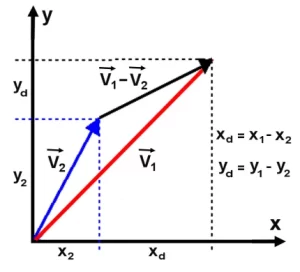This online Vector Subtraction Calculator finds the difference of any two 2D or 3D vectors represented as sets of Cartesian coordinates. To get the result just enter the known values of the vectors coordinates into the input fields of this calculator and click the ‘Calculate’ button.
What is a Vector
Vectors are fundamental mathematical objects that play an important role in various scientific disciplines, including physics and engineering. They provide a concise and efficient way of representing quantities that have both magnitude and direction.
In mathematics, a vector is an object consisting of two main components: magnitude (or length) and direction in space. In diagrams and graphs, vectors are usually depicted with arrows and denoted by bold letters or letters with arrows, such as \(\textbf{V}\) or \(\overrightarrow{V}\).
Any vector can be uniquely defined by its projections on the coordinate axes in the space in which it acts. In other words, a vector can be algebraically defined by a set of numbers that can be considered as its components. For example, in a three-dimensional Cartesian coordinate system, any vector can be represented as follows:
$$\overrightarrow{V} = \{ V_x, V_y, V_z \}.$$
Vector Subtraction
Vector subtraction involves finding the difference between two vectors, resulting in a new vector known as the resultant vector. This is a mathematical operation that takes into account both magnitudes and directions of these two vectors.
When vectors are defined graphically, it is most natural to use geometrical methods of subtraction. The geometrical method of vector subtraction, also known as the graphical method, is an approach to combining vectors visually using geometric constructions. It involves drawing vectors as directed line segments or arrows and using geometric operations.

First, we need to define vector subtraction. To subtract the vector \(\overrightarrow{V_{2}}\) from the vector \(\overrightarrow{V_{1}}\), it is necessary to find such a vector of the difference \(\overrightarrow{V_{d}}\) = \(\overrightarrow{V_{1}}\)–\(\overrightarrow{V_{2}}\) for which the relation \(\overrightarrow{V_{1}}\) = \(\overrightarrow{V_{2}}\) + \(\overrightarrow{V_{d}}\) will be valid.
Thus vector subtraction is related to the more familiar and intuitive process of vector addition. Returning to the graphical representation of vectors, we see that in order to find vector \(\overrightarrow{V_{d}}\), we need to place the tails of vectors \(\overrightarrow{V_{1}}\) and \(\overrightarrow{V_{2}}\) at one point, and then draw the difference vector from the head of vector \(\overrightarrow{V_{2}}\) to the head of vector \(\overrightarrow{V_{1}}\). That is, the tail of vector \(\overrightarrow{V_{d}}\) coincides with the head of vector \(\overrightarrow{V_{2}}\), and the head of vector \(\overrightarrow{V_{d}}\) coincides with the head of vector \(\overrightarrow{V_{1}}\). The length and direction of vector \(\overrightarrow{V_{d}}\) represent the magnitude and direction of the resultant vector.
The algebraic method of vector subtraction consists of subtracting the corresponding components of the vectors involved. For instance, if we have two vectors \(\overrightarrow{V_{1}}\) and \(\overrightarrow{V_{2}}\) in 2D space, their difference, denoted as \(\overrightarrow{V_{d}}\), is computed as follows:
$$\overrightarrow{V_{d}} = \{ x_d, y_d\} = \overrightarrow{V_{1}} \ – \ \overrightarrow{V_{2}} = \{ x_1-x_2, y_1-y_2 \},$$
where \(x_i\) and \(y_i\) are x- and y- components of the vector \(\overrightarrow{V_{i}}\).
This formula can be generalized to spaces of different dimensions. Our online Vector Subtraction Calculator is able to easily calculate the difference of two vectors defined by their Cartesian components in 2D or 3D spaces.
Properties of Vector Subtraction
Vector subtraction, like any mathematical operation, possesses certain properties that define its behavior and characteristics. The properties of vector subtraction are as follows:
• Commutativity: Vector subtraction is not commutative, which means that changing the order of the vectors being subtracted will result in a different resultant vector. In other words, \(\overrightarrow{V_1}\) – \(\overrightarrow{V_2}\) is not necessarily equal to \(\overrightarrow{V_2}\) – \(\overrightarrow{V_1}\). The order of subtraction affects the direction of the resultant vector.
• Associativity: Vector subtraction does not follow the associative property. For three vectors \(\overrightarrow{V_1}\), \(\overrightarrow{V_2}\) and \(\overrightarrow{V_3}\), (\(\overrightarrow{V_1}\) – \(\overrightarrow{V_2}\)) – \(\overrightarrow{V_3}\) is not equal to \(\overrightarrow{V_1}\) – (\(\overrightarrow{V_2}\) – \(\overrightarrow{V_3}\)). The order in which vector subtraction is performed affects the final result.
• Additive Identity: The zero vector {0, 0} serves as the additive identity for vector subtraction. Subtracting the zero vector from any vector \(\overrightarrow{V}\) results in the vector itself: \(\overrightarrow{V}\) – \(\overrightarrow{0}\) = \(\overrightarrow{V}\).
• Inverse: Every vector \(\overrightarrow{V}\) has an additive inverse, denoted as –\(\overrightarrow{V}\), which, when added to \(\overrightarrow{V}\), yields the zero vector: \(\overrightarrow{V}\) + (-\(\overrightarrow{V}\)) = \(\overrightarrow{0}\). Similarly, vector subtraction can be expressed as \(\overrightarrow{V_1}\) – \(\overrightarrow{V_2}\) = \(\overrightarrow{V_1}\) + (-\(\overrightarrow{V_2}\)).
• Triangle Inequality: The triangle inequality holds for vector subtraction. For two vectors \(\overrightarrow{V_1}\) and \(\overrightarrow{V_2}\), the magnitude of their difference, ||\(\overrightarrow{V_1}\) – \(\overrightarrow{V_2}\)||, is always less than or equal to the sum of their magnitudes: ||\(\overrightarrow{V_1}\) – \(\overrightarrow{V_2}\)|| ≤ ||\(\overrightarrow{V_1}\)|| + ||\(\overrightarrow{V_2}\)||. This property is essential in geometry and plays a role in proving inequalities involving vectors.
• Distributive Property: Vector subtraction follows the distributive property with scalar multiplication. For a scalar \(c\) and vectors \(\overrightarrow{V_1}\) and \(\overrightarrow{V_2}\), \(c\)(\(\overrightarrow{V_1}\) – \(\overrightarrow{V_2}\)) is equal to \(c\)\(\overrightarrow{V_1}\) – \(c\)\(\overrightarrow{V_2}\). So the scalar multiplication can be distributed over vector subtraction.
Related calculators
Check out our other algebra calculators such as Cross Product Calculator or Vector Addition Calculator.